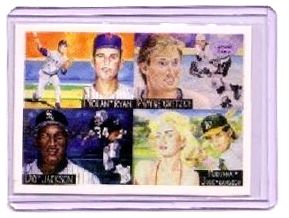Below are short bits & pieces on sportscard & baseball trading card collecting.
Please wander around the website for more info, prices, values & images
on vintage baseball, football, basketball, hockey, sport and non-sports cards.

1971 Kellogg's
1971, Kellogg's second and by far scarcest and most valuable set,
contained 75 different players on 2 ¼” by 3 ½” cards.
The cards were plastic coated giving them a 3-D look !!!
The plastic coating also made high grade cards nearly impossible find.
Over time and the elements, most cards would curl making light and heavy
cracks very common.
As opposed to Kellogg's other issues which were available from the company as complete sets,
1971 Kellogg's cards were ONLY available one in each specially marked box of Kellogg's cereal.
The only way to complete your 1971 Kellogg's set was to pester mom to buy, buy, buy more boxes of cereal.
In addition to the 75 different players, numerous scarcer variations exist
with minor differences in the stats on back. In addition, all 75 cards and
some variations are found with 2 different forms of copyright on the back:
XOGRAPH ( 80 total cards)
@1970 XOGRAPH (121 total cards)
The numbers above may not be 100% accurate.
The "toughest" cards appear to be:
# 7 Alou (1970 Oakland NL)
# 28 Wright (Angles Crest Logo)
# 54 Johnson (Angles Crest Logo)
# 64 Fregosi (Angles Crest Logo)
# 70 Osteen (No Number on back)
# 2 Seaver (ERA 2.81)
# 41 Gaston (113 Runs)
# 65 Rose (RBI 485)
|

Autographed Gateway Cachets
Gateway Stamp Company has provided collectors well over 1 MILLION
authenticated certified autographs over the last 30 years.
Silk Cachets from Gateway Stamp Company
Even though a "stamp company", Gateway rarely dealt in stamps, going down
a new and creative road becoming one of the world's most unique secrets in
autograph collecting combining the best in art, color photographs, history
and autographs with their full-color silk cachet envelopes. Gateway's first
client was Cardinals Hall of Famer Lou Brock with hundreds to follow.
WHAT ARE FULL-COLOR SILK CACHETS?
A "cachet" is a message or design on an envelope marking a postal event.
"Full-color silk" refers to the delicate material into which the
original art and photography are printed. After which each silk is applied
to the envelope, signed by the player and then officially post-marked by the
U.S. Post Office IN THE CITY OF THE EVENT !!!
WHY POSTMARKS?
The key to EVERY Gateway cachet is the postmark.The best way to mark a date
in history is with a postmark. The rules governing the granting of
postmarks GUARANTEE that NO Gateway issue can EVER be re-issued protecting
the value of the autographed, postmarked cachets !!!
|

1991 Cardboard Dreams Baseball Cards
Checklist & Values


Neat oddball set with a very unusual mix of players.
A promotional lead-in for "Cardboard Dreams" a soon to be
sportscard magazine. Promo cards were given out at a few
regional baseball card shows mostly in So. Cal.
MLB filed lawsuits against similar magazines and the magazine was
cancelled before 1st issue leaving just a small run of promo
cards (limited to 5,000) and some scarce proofs.

SERIES 1 SERIES 2
#1 Willie Mays # 9 Mickey Mantle
#2 Nolan Ryan #10 Nolan Ryan & Sandy Koufax
#3 Tony Gwynn #11 Frank Thomas & David Justice
#4 Wayne Gretzky #12 Brett Hull
#5 Jose Canseco/Madonna #13 Ted Williams & Joe DiMaggio
#6 Ken Griffey Jr #14 Barry Sanders
#7 Bo Jackson #15 Dan Marino
#8 Michael Jordan #16 Magic Johnson & Larry Bird
Prototype #1: Nolan Ryan / Wayne Gretzky / Bo Jackson / Jose Canseco & Madonna
Prototype #2: Mickey Mantle / Nolan Ryan & Sandy Koufax
Ted Williams & Joe DiMaggio / David Justice & Frank Thomas
Click for complete
1991 Cardboard Dreams Baseball card listings
Note: You may be on that page now.
|

Tobacco Cards
Starting approximately in 1886, sportscards, mostly baseball cards, were often
included with tobacco products, for promotional purposes and also because the
card reinforced the packaging and protected cigarettes from damage. These sports
cards are referred to as tobacco cards in the baseball card hobby. Over the next
few years many different companies produced baseball cards. Tobacco cards soon
started to disappear as the American Tobacco Company tried to develop a monopoly
by buying out other companies.
They were reintroduced in the 1900s, as American Tobacco came under pressure from
antitrust action and Turkish competition. The most famous and most expensive,
baseball card is the rare T206 Honus Wagner. The card exists in very limited
quantities compared to others of its type because Wagner forced the card to be
removed from printing. It is widely (and incorrectly) believed that Wagner did
so because he refused to promote tobacco, but the true explanation lies in a
dispute over compensation.
Soon other companies also began producing baseball and football cards. Sports magazines
such as The Sporting News were early entries to the market. Candy manufacturers
soon joined the fray and reflected a shift toward a younger target audience for cards.
Caramel companies were particularly active and baseball cards were one of the first
prizes to be included in Cracker Jacks. World War I soon suppressed baseball card
production.
© 1995-2019 "InterNet's Baseball Card Store" / Joseph Juhasz ... All Rights Reserved
|








